Consulting Frameworks in the Toolkit of FP&A: Porter’s Five Forces
Some companies thrive and gain huge profits, while others can’t survive and go broke. Is market competition Darwinian? Could Darwin’s tenet “survival of the fittest” explain this phenomenon? Even though “On the Origin of Species” (1859) discusses the reasons behind the survival and extinction of biological species, these concepts could be relevant to the world of economics and business.
Natural systems are markets of pure and perfect competition where living organisms compete for limited natural resources, such as food, water, living space, etc. Those biological species survive who are best adapted to the environment.
Processes which take place on the competitive markets can be compared to natural selection as firms compete for the resources as well, for instance, for materials, labor force, time and money. Accordingly, companies that better fit their business environment benefit from the process of selection while others either try to imitate the “fittest” or go bankrupt.
To avoid becoming victims of this selection companies should have a deep understanding of the environment they perform their activities in as well as the factors driving or constraining profitability.
How can they obtain these insights and evolve towards better fit?
In the previous article of the series we discussed PESTEL framework which helps assess the impact of the macroenvironment on the market and company’s performance. However, macroenvironment is not the only external factor influencing organizations, there are industry factors represented by five forces shaping competition on the market and described by Michael E. Porter: threat of new entrants, power of suppliers, power of buyers, threat of substitutes, rivalry among existing competitors.
Threat of new entrants
Profitable industries attract new entrants which bring new capacities trying to gain market share. This forces current market players to keep prices down and invest more to deter newcomers. The level of threat of new entrants depends on the existing or potential barriers to entry, such as:
economies of scale
cost of building brand awareness
customer switching costs
upfront investments
access to distribution channels
governmental policies, etc.
The table below illustrate how each of the factors intensifies or reduces the strength of the threat.
Industries with high barriers to entry: telecommunication (high upfront investments), transportation (heavy regulations), ERP software (high switching cost).
Industries with low entry barriers: professional services.
Power of suppliers
Suppliers use their negotiating power to capture more value for themselves by charging higher prices, reducing quality and/or demanding better terms from their customers. These actions decrease industry profitability. The main factors that determine the level of power of suppliers on the market are as follows:
number, size and independence of the suppliers
uniqueness of the supplier’s product
switching cost between the suppliers
possible forward integration, etc.
Industries with powerful suppliers: pharmaceutical industry (patents contribute to the differentiation of the drugs).
Industries with little power of suppliers: food industry.
Power of buyers
Customers use their negotiating power to capture more value for themselves by demanding lower prices, better quality or more products/services at the same price. This has a negative impact on industry profitability. To assess the level of power of buyers on the market following aspects should be considered:
number, size and independence of the buyers
differentiation vs competitors’ products
switching costs buyers may face while changing vendors
price sensitivity
possible backward integration, etc.
Industries with powerful buyers: industries with intermediate buyers (buyers which are not the end users of the product), for example, various distributors of electronics, equipment, jewelry, etc.
Industries with little power of buyers: pharmaceutical industry if the generic drug is not available
Threat of substitutes
Substitutes are products that perform the same or similar functions as the product of the analyzed industry but by different means. The existence and strength of substitutes may put price ceiling for industry’s products and as a result limit profitability. The factors defining the level of the threat of substitutes are as follows:
number of substitutes
buyer’s propensity for substitution
price/value ratio of the substitute
perceived level of differentiation of the industry product vs its substitutes
buyer’s switching costs, etc.
Industries with high threat of substitutes: television, cinemas with appearance of streaming services.
Industries with weak threat of substitutes: water supplied by local utilities.
Rivalry among existing competitors
Rivalry among existing competitors is the essence of competition and the most familiar of the five competitive forces. High rivalry usually drives down industry’s profitability, especially if companies compete only on prices. However, when assessing the intensity of rivalry, numerous aspects should be considered:
number and size of the competitors
industry growth rate
barriers to exit
product differentiation
pressure on prices
buyer’s switching costs, etc.
Industries with intense rivalry among existing competitors: airlines, hospitality.
Industries with weak rivalry among existing competitors: PC operating systems.
The carousel below illustrates which of the factors intensify or reduce threats coming from various competitive forces.
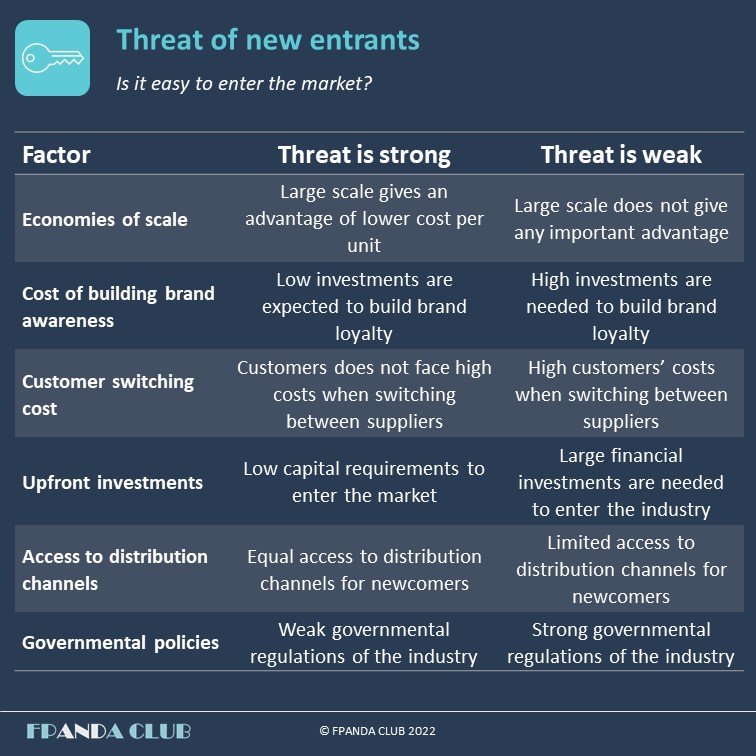
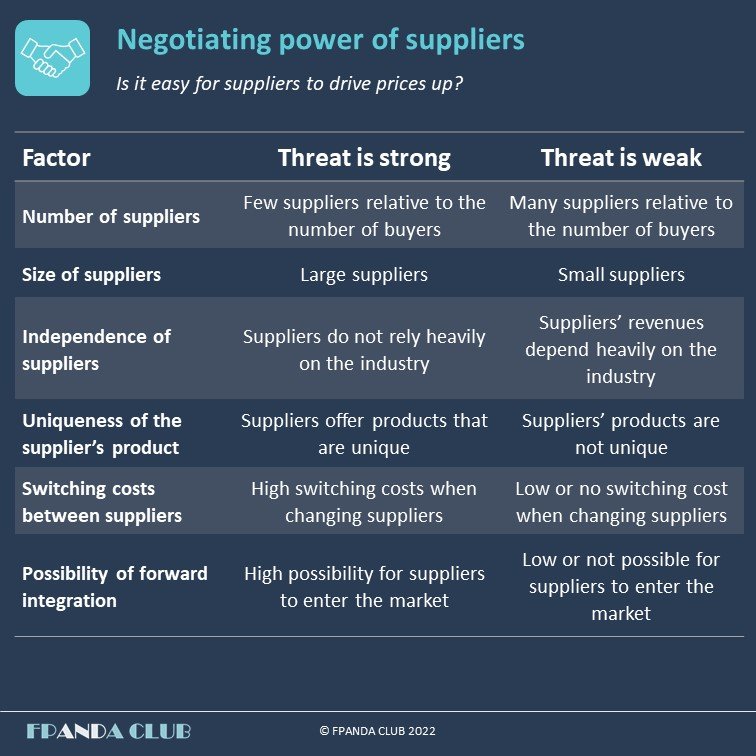
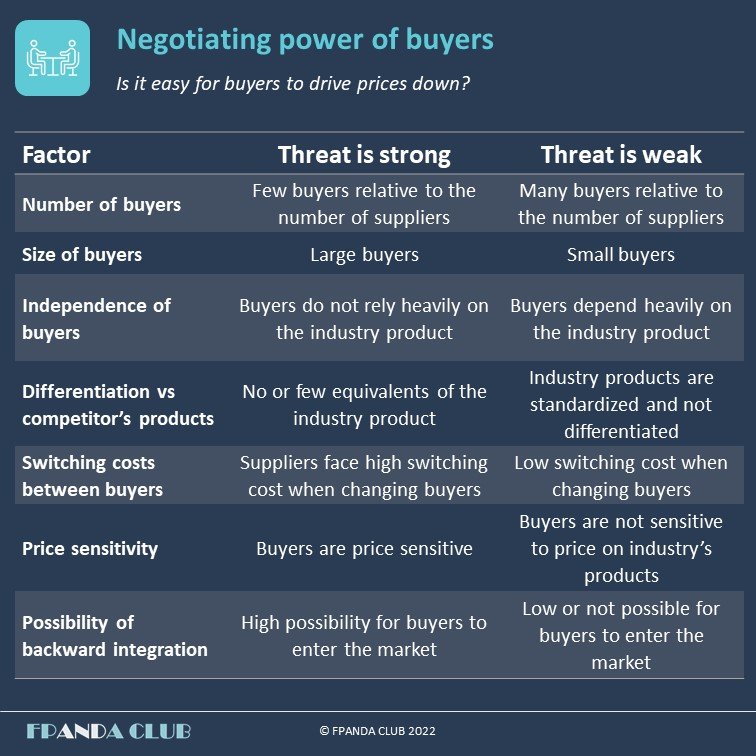
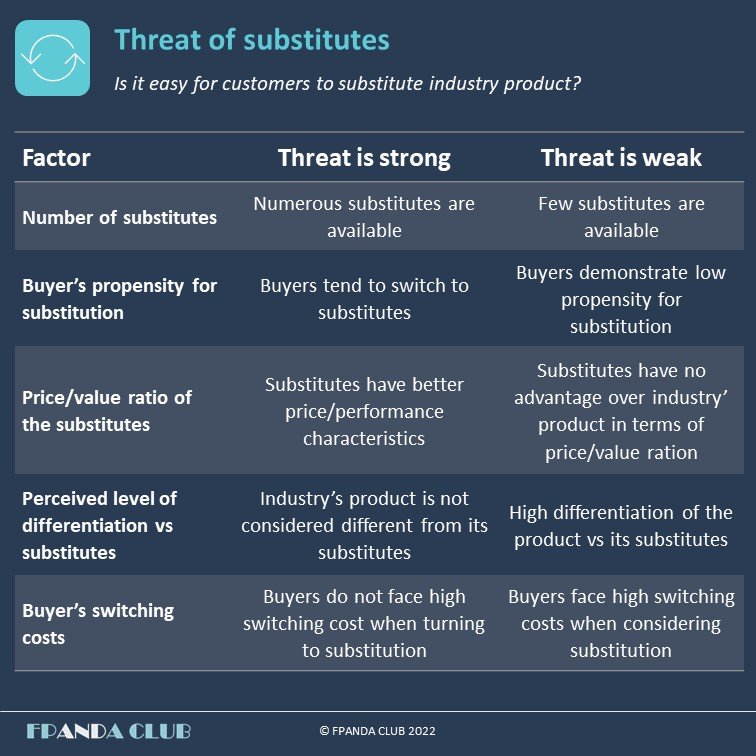
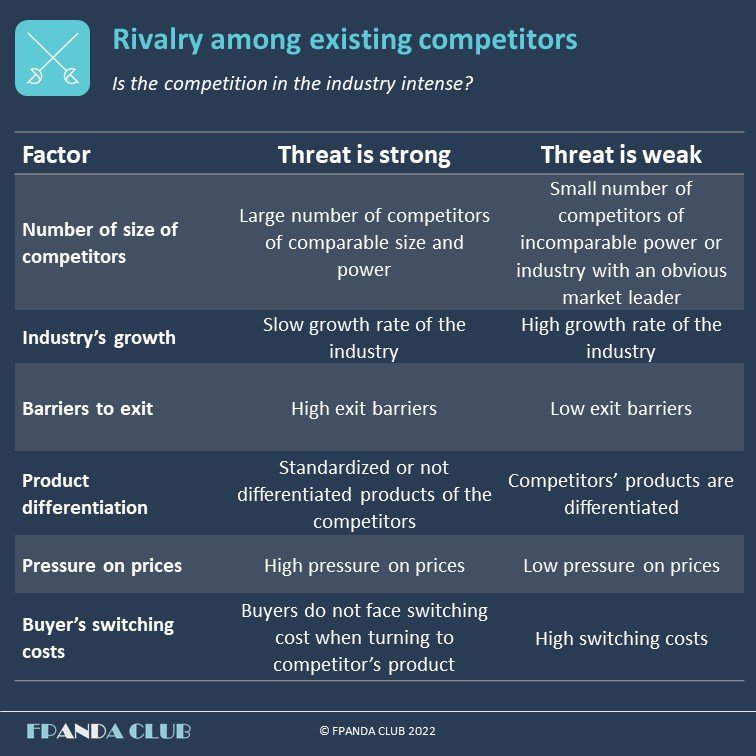
Porter’s five forces framework aims at deep understanding of the industry structure to anticipate competition, understand the root causes of the industry profitability and, therefore, gain or maintain more profitable or less vulnerable position on the market by incorporating industry factors into the strategy.
The strength of competitive forces influences prices, costs and investments to compete, thus, they have direct impact on current and future profitability of the market participants which is FP&A’s area of interest.
To perform insightful analysis of the competitive forces FP&A teams should follow these steps working together with other services of the company:
Define the relevant industry based on the product and geographical scopes of competition
Identify industry structure by segmenting industry participants and defining competitive forces
Determine the power of each competitive force based on the underlying drivers
Analyze overall industry profitability as well as the positioning of more profitable participants vs the given company
Analyze recent and potential changes in the industry structure and anticipate their impacts
Identify elements of the industry structure that could be influenced by competitors and by the given company, elaborate action plans.
Incorporate action plans into company’s strategy.
Follow up the initiatives to assess the efficiency of action plans.
When using Porter’s 5 forces model analysts may identify numerous factors intensifying one or several competitive forces. Depending on the range of these factors a number of solutions may exist to neutralize forces constraining industry and/or company’s profitability, for example:
To mitigate the threat of new entrants: increase fixed cost by investing in R&D, invest in brand awareness, secure exclusive access to core sales and distribution channels.
To reduce the power of suppliers: diversify suppliers, standardize inputs and parts to switch between suppliers, think of backwards integration of the supplier, etc.
To neutralize the power of buyers: find new channels to reach end users to address the issue of powerful distribution channels, expand the range of complimentary products/services to keep the customer in the system and increase switching cost, use pricing strategies to encourage loyalty, increase differentiated value of the product, etc.
To reduce the threat of substitutes: offer better value vs substitutes.
To decrease rivalry with existing competitors: invest in innovation, differentiate the product from the products of competitors in terms of features, complimentary services, brand image, etc.
Different options may also be available to exploit weaknesses of the competitive forces.
FP&A teams acting as internal business advisors do not just report changes in company’s or industry profitability. They contribute to the improvement of the company’s position by identifying strengths and weaknesses of the company vs competitive forces, anticipating and benefiting from the changes in the industry structure, shaping new industry structure which is more favorable to the company, developing strategies and action plans to neutralize forces with negative impacts and reduce the share of profits going to suppliers, buyers, substitutes, competitors or new entrants.
